Haplogroups fascinate me because they reveal our deepest ancestry. A haplogroup is a way of assigning a portion of your DNA to a category based on areas of very slowly changing markers. There are two types of DNA that can be assigned haplogroups, because they do not recombine therefore change only slowly via mutations. These are the Y chromosome and the DNA of your mitochondria (mtDNA), which are separate organisms in every cell that provide us with energy and are passed along via a mother’s egg. The groupings for their haplogroups look like family trees when charted, for example the one shown below from Eupedia. That is because each mutation creates a new branch. There are haplogroups assigned for both the all female line (mtDNA) and the all male line (Y). Click here for Eupedia’s wonderful descriptions of all the haplogroups found in Europe.

The female H haplogroup from Eupedia.com on haplogroups
Men have a Y chromosome, which makes them male, which has been passed from father to son, to his son, to his son, and so forth from from time immemorial. We all have mitochondrial DNA (mtDNA ) which is passed from a mother to all her children unchanged. Thus your mtDNA is from your mother’s mother ‘s mother and so on. Both of those parts of DNA inheritance can be traced back to the dawn of humanity. That is unlike the other chromosomes which mix the inheritance from each parent such that after several generations there may be little or no trace of our deeper ancestors. Most of us have no verifiable autosomal DNA from before our 5th grandparents.
Those of you who have family legends about descent from an Indian princess might be able to prove the connection using mtDNA if there is a direct female line to that ancestor, since there are specific haplogroups for Native Americans (click here for the wikipedia article on that).

My Ancestral Haplogroups displayed in Paul Hawthorne’s colorful genealogy chart
One thing that I like to do is figure out the haplogroups of my recent ancestors by testing cousins in the needed line of descent. I made a chart of the ones I know using Paul Hawthorne’s colorful genealogy chart (click here for more about that) with the haplogroups added. As you can see, I have many more lines to chase down. Sadly my Thannhauser Bavarian Jewish line daughtered out, so I am trying to find a male descendant of the one who moved to Albany NY in the mid 1800s.
So how do you find your haplogroup from your DNA test? Well if you tested at 23andme or Living DNA then you will be provided with your high level haplogroup. However if you want to drill down the branches, then test your Y and/or your mtDNA at Family Tree DNA (summer sale until end of August). Ancestry tests enough SNPs to get a high level haplogroup by using other tools on your raw data. My Why Y blog post explains how to use the Morley tool but there is also a tool to find Y haplogroups from Borland Genetics. I have been trying to convince Kevin Borland to write one for mtDNA since the James Lick mthap tool will not currently take ancestry data.
The nomenclature for haplogroups can be confusing. Originally a haplogroup might be called R1b1a2a which was nice for tracing down the branches but soon got very cumbersome when it became far too many characters, for example R1b1a2a1a2c1k1c1. So the naming was changed to be the top group – say R – then the final tested SNP, for example L238. At 23andme my R1b etc Dad is listed as R-P312 which is a SNP uptree from his L238 but downtree from M343 which is the start of the R1b tree. ISOGG keeps a list of the SNP trees of each Y haplogroup here: https://isogg.org/tree/ but the Eupedia charts may be easier to read, click here for their R1b article.
Since my Dad had his STRs tested at ftDNA, and I knew from his 23andme test that he was an R1b-P312, I bought the P312 SNP pack there and discovered he was a L238 with some more downtree SNPs. I subequently joined the R1b-L238 facebook group. There are many facebook groups and projects at FtDNA for specific subgroups like this. The L238 group admin showed me that his terminal Y11662 SNP is from the Swedish branch of L238 that went to Rogaland, Norway. This was not the expected Norwegian branch of L238 which even includes one of his autosomal matches! Apparently that matching DNA is not from the all male line.
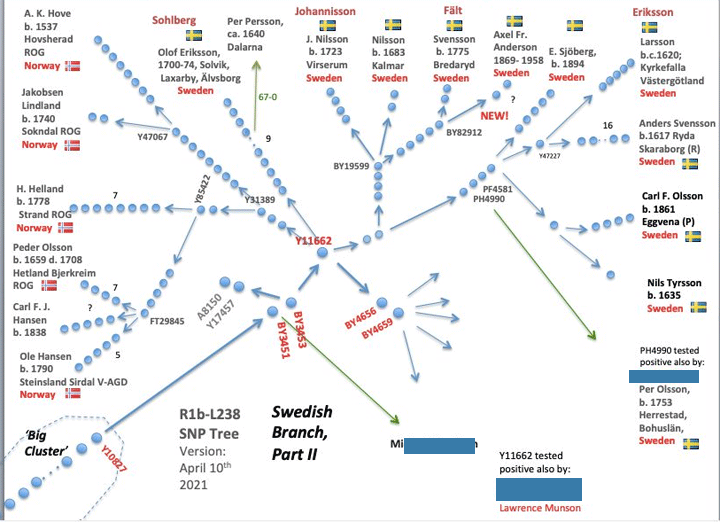
Swedish branch of R1b-L238 as diagrammed by Timo Rossi in the R-L238 Facebook group
My blog post called Why Y explains the differences between STR and SNP testing on the Y chromosome. Basically SNPs tell you the haplogroup and STRs can give you genealogically relevant matches.
So what about the mtDNA, the mother’s mother’s mother’s line?
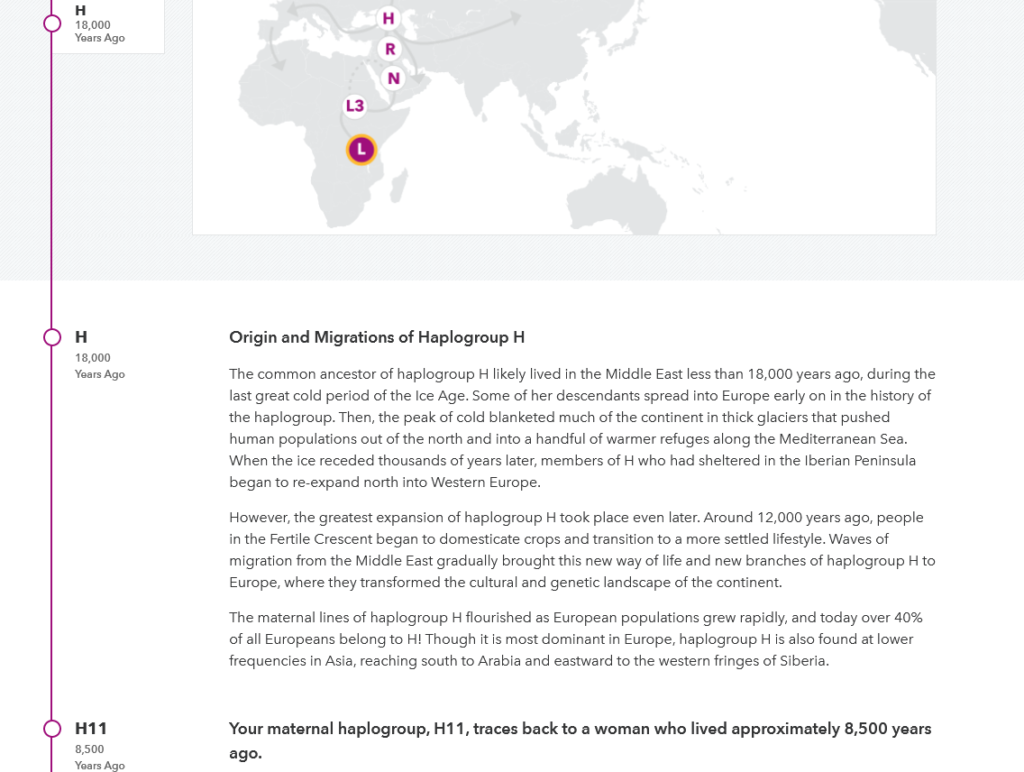
23andme has much information about your haplogroups. This is my mtDNA group.
MtDNA changes even more slowly than the Y SNPs so is mainly useful for learning your haplogroup which can tell you something about your ancient ethnicity. It was a book about mitochondrial DNA, The Seven Daughters of Eve: The Science That Reveals Our Genetic Ancestry by Bryan Sykes, that sparked my interest in genetic genealogy and led to my first DNA test.
Your raw DNA data from Ancestry contains enough mtDNA to get a basic haplogroup. However the current format is not compatible with the calculator written by James Lick. If anyone knows of a way to convert the Ancestry data to one of the formats he wants let me know. I am considering coding up something myself. UPDATE 29-AUG-2021: My mtDNA expert has looked at a number of Ancestry kits and tells us that there is usually not enough data for “chromosome 26” to determine the haplogroup.
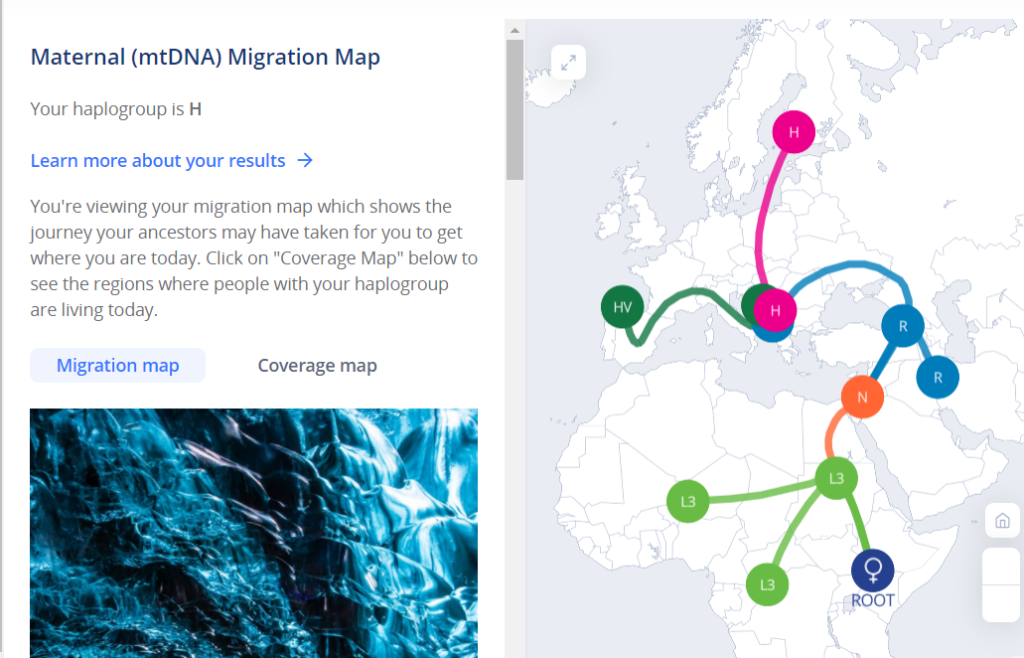
The mtDNA display from Living DNA is the nicest in my opinion
I am also told that you can determine your mtDNA haplogroup from Promethease, the site which will analyze the medical data in your raw DNA but it is not easy to do and when I tried it several years ago I could not figure it out.
If Eupedia does not have much about your haplogroup, try Wikipedia. It has some great articles on the subject. Or just google your haplogroup and see what you can find.
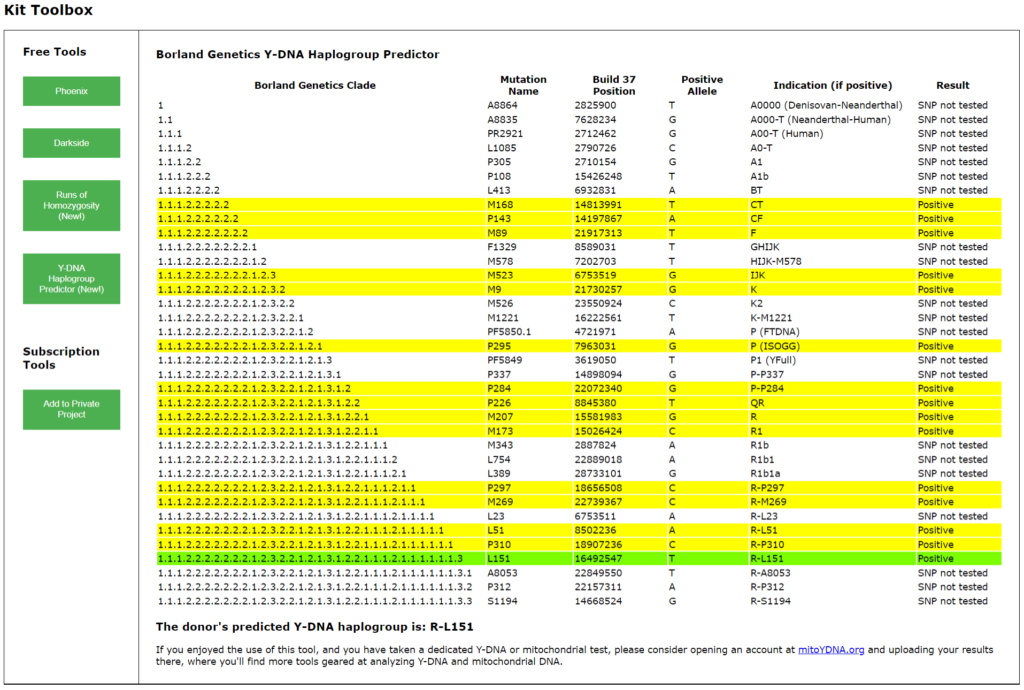
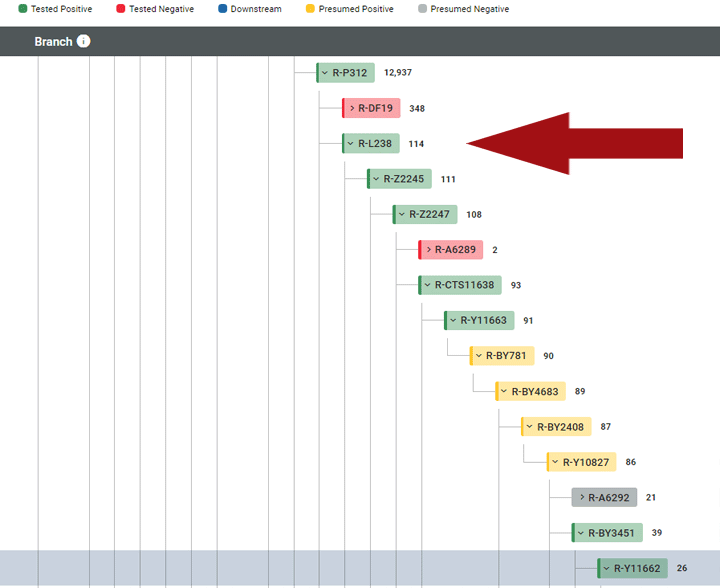
Kitty,
Very sorry to hear of the death of your husband. Hoping you are doing ok in all ways. Taking care of my bed bound wife has me thinking about things like that.
Can you tell me of a very simple program that will take a gedcom file input and create a pdf x chromosome ancestor pedigree chart? Or can you write one?
Jay, have you tried uploading your gedcom to DNA Painter? You can see the X by clicking one button. It’s very slick!
Thank you Jim… Wikitree, which is a collaborative one world tree, will make those diagrams of the ancestors you can have X from. So add your tree there.
I have a question and was curious if my mother’s mtdna would be the same for me (male) thank you.
Yes you will have the same mtDNA as your mother since she gave you your mitochondria
Thank you Kitty
There is evidence for mt-DNA recombination. Thus, there is a chance you have heteroplasmy of maternal and paternal mt-DNA. That’s recombination at the mitochondrial level.
https://www.nature.com/articles/6800572
You can also have heteroplamy from only maternally inherited mitochondria. In this case, different tissues may have different proportions of mt-DNA. We see this in human mt-diseases where different family individuals have different organs affected and where the disease is dynamic with changes in heteroplamy over time within an individual.
There are some interesting variations on mt-DNA inheritance in other species
https://www.ncbi.nlm.nih.gov/pmc/articles/PMC5282644/
Thank you David, very interesting… My blog posts are usually an attempt to simplify difficult DNA concepts and explain them in plain English so I did not touch on this rare but interesting possibility.
Thanks David, I will be sure to check the links out.
Wonderful article and breakdown. I have grown more knowledgeable concerning this aspect over the years with your assistance while doing my own Genetic breakdown’s of my DNA !
Seven Daughters of Eve started my journey as well.
This may be a silly question, but how do you pronounce STR is it S-T-R or star? Also I think I have heard SNP pronounced snip. Is that correct?
I have heard them pronounced as STiR and SNiP
From FTDNA my mtDNA Haplogroup is J2a1a1a2.
You write that mtDNA changes very slowly.
So, apart from my mother, will this have been her mother’s, her mother’s mother’s, etc and so on?
Should I upload this to any other diagnostic or sharing site?
FtDNA does the deepest mtDNA testing so no need to upload elsewhere although you might find It of interest to upload to https://www.mitoydna.org/
Thanks Kitty but you slightly misunderstood me (or my wording was as usual wanting).
I meant would I be able to tree
tag each maternal line progenitor with this haplogroup. Then that would be available to other descendants researching these women who have not themselves tested mtDNA?
Hi,
I also looked at the Prometheus haplogroup information. All the Snps were H, H1, H3 etc. I’m confused because I’m J1c5. Any good sites to explain this?
Thank you!
Mary Rosica
Sorry Mary, I find it confusing too. If you uploaded Ancestry data then there are not enough of the relevant SNPs tested to determine yout mtDNA haplogroup/ Their documentation seems mainly about the Y groups
https://faq.promethease.com/en/article/how-can-i-see-my-haplogroup
Hi
So my understanding is one can’t predict once Mtdna from ancestries autosomal test results.
Am i correct?
Yes you are correct
Pingback: Friday’s Family History Finds | Empty Branches on the Family Tree